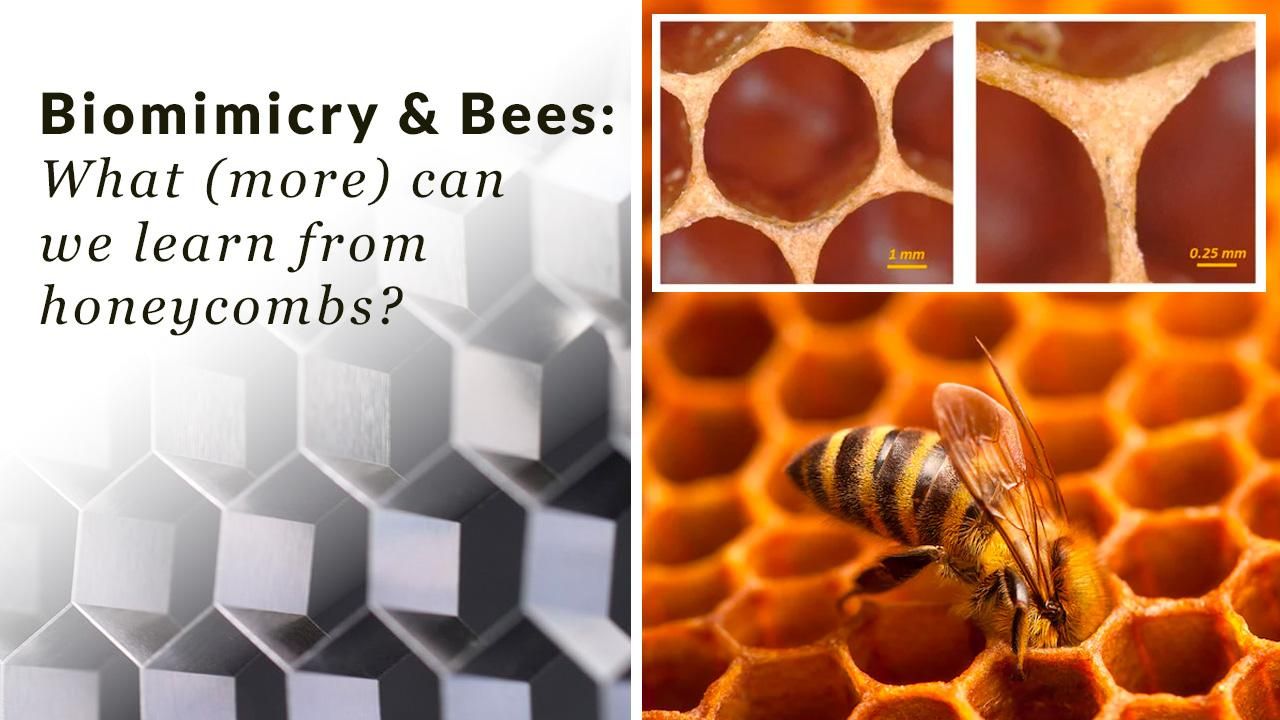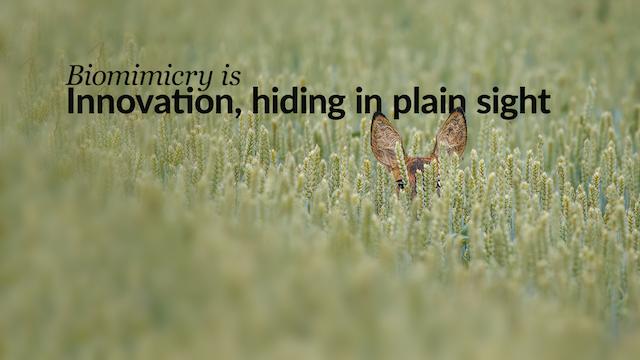Biomimicry and Bees: What (more) can we learn from honeycombs?

It’s no secret. Honeycombs are the poster child of biomimicry design.
An effective design like no other, made with love by nature’s sweet (and buzzy) six-legged engineers.
Slap the honeycomb structure on any design—and voila, you just made it stronger, possibly sustainable, and even improved the look of your design too.
Within this article, we cover two things: Why the hexagon is a genius construction shape, PLUS a new discovery that makes it even more awesome, and applicable.
1. What makes hexagons awesome:
They are a genius shape for construction, because of two fundamental principles: a) More volume with less material, and b) It is highly resistant to buckling (when squashed “top to bottom”). Aeronautical engineers and packaging designers LOVE this combination of optimisations.
2. What makes hexagons (even more) awesome:
That's what we're set to explain. Having been studied for over 2000 years... is there anything more we can discover from honeycombs?
PS - Interested in design? Explore our article: What (Really) is Biophilic Design?
What (more) can we learn from biomimicry and the honeycombs of bees?
Honeycombs are the basis of countless nature-inspired innovations. From cooling materials to crash-resistant aeroplanes to providing architectural structural stability, honeycombs express nature in our human designs.
A research team funded by NASA has made a remarkable (and somewhat recent) discovery. The human-made honeycomb structures we see today are very sharp corners... and the study of social insect nests (specifically bees and wasps), led the team to a simple yet powerful insight. These honeycomb structures are never at sharp angles. Rather, they're more rounded. Some might even say organic.

Notice the sharp corners on the human-designed honeycomb structure and the organic, softer corners of a bee's honeycomb. This evidence of a non-zero corner radius for honeycombs raises the question: what structural benefit may this serve?
What is the optimum corner radius that a human-designed honeycomb should have, and in which context?
Three key insights suggest the following benefits of a rounded corner:
1. A rounder corner increases the geometric efficiency of stiffness.
In other words, if the only design objective was to optimize only for stiffness, a complete circle would be the most efficient structure.
2. There does exist an optimum corner radius for a given honeycomb cell, and its value increases as beams get thicker.
3. Finally, the presence of a corner radius mitigates against fracture at the node which is observed for
thicker beams. This is well suited to energy absorption applications (such as aircraft, spacecraft, cars, etc).
Bees have evolved a circular* internal cell shape for their honeycomb, which optimises for strength over light-weighting. Why? Beehives need to be strong enough to hold many kilograms of honey and grubs for extended periods of time, without deforming. On the other end of the spectrum, paper wasps and hornets use an almost perfectly hexagonal internal cell structure, and the result is an extremely lightweight but more fragile nest (which works well for their nesting strategies and short-term-only use).
*We can describe how circular the interior of the hexagonal cells are, using the metric of “corner radius”, i.e. how round are its internal corners? A “zero corner radius” means that the corners are not rounded at all (i.e. a perfect hexagon). A “non-zero corner radius” means that it is rounded to some extent (from just slightly, up to a perfect circle).
So how did this discovery come about, and how was it that this insight has been hiding in plain sight?
To answer that, we need to look back in time.
The history of studying the honeycomb structure
In 36 B.C. the Roman beekeeper and polymath Marcus Terentius Varro speculated honeycombs have hexagonal cells to save wax while storing more honey. Bees work smart, not just hard.
This became known as “The Honeycomb Conjecture”.
The honeycomb conjecture explained by the mathematician (Thomas Hales) who solved this 2000-year-old question. If this is too mathematical for you, consider signing up for the Biomimicry Short Course Set
In simple terms— hexagonal patterns require the least perimeter to divide space into identical regions, allowing for stronger structures with the least material.
For centuries people accepted the honeycomb conjecture as a reasonable explanation, but it was only in 1999 that American scientist Thomas Hales produced mathematical proof that Varro's theory was right.
So what makes the unique structure so great, and how is it that honeycomb structure is found on almost every aircraft and spacecraft today?
What makes the Honeycomb structure perfect for aircraft design?
The honeycomb structure has a high strength-to-weight ratio, i.e. honeycombs are strong AND lightweight.
They can withstand a lot of force while minimising material usage.
The aviation and space industry in particular are fans of this nature-inspired design. Honeycomb sandwich panels are found throughout aeroplane components - from the fuselage and wings, to the ailerons and flaps You can even find honeycomb structures in the design of the toilet!
Every commercial aircraft depends on the integrity and reliability offered by the honeycomb structure. Whenever lightweight is a premium, honeycomb sandwich construction is very difficult to beat.
How did this novel honeycomb discovery come about?
People have been studying honeycombs for two thousand years. Is there really more to learn?
Dr Clint Penick, associate professor at Kennesaw State University is a biologist with a deep passion for ants and other social insects like bees.
As fate would have it, when he was working at the Biomimicry Center of the Arizona State University he struck an unlikely collaboration with Dhruv Bhate— an engineer.
Dhruv was a specialist in 3D printing and worked on industrial honeycomb structures, but he had interestingly never seen one made by bees. Dhruv needed a biologist’s opinion and sought Clint’s help.
They began working together, and the duo stumbled upon a startling revelation— the artificial honeycombs produced industrially were composed of perfect hexagons with sharp corners, but the ones bees make tend to have rounder corners.
Clint and Dhruv successfully convinced NASA to fund them and researched on functional uses of their new learning. They pursued the best honeycomb shape that can be included in designs. Focusing on three key variables— the size of the hexagon cell, the thickness of the cell wall and corner rounding— they studied nests of over seventy species of bees and wasps.
Initially, they found that maximum corner radius enhanced stiffness and decreased material usage in a honeycomb structure. But Clint, being a biologist, pointed out that bees would want their nests to be capable of dealing with stress too.
This led them to an incredible (yet simple) discovery: If the walls of the hexagon cells were thick, adding corner rounding decreased stress and created a strong honeycomb. If walls were thin, adding corner rounding increased stress and resulted in a weaker structure. Therefore, using the ratio of cell size and cell wall thickness, we can figure out the ideal corner roundness and optimize a honeycomb structure.
It's quite a coincidence that a biologist met an engineer, and collaborated to create such a discovery. How might we re-create such conditions? The short answer is interdisciplinary collaboration.
Why biomimicry requires more than just biologists
Biologists are rarely invited to the design table. Naturally, a grave mistake. Biologists can read nature like a book and use this to create sustainable and life-friendly designs.
Biomimicry has become synonymous with nature-inspired innovation, and innovation is a combination of people and ideas. It requires people from different fields to collaborate. Engineers, computer scientists, mathematicians, physicists, biologists, beekeepers, and even textile designers and artists.
When you start mixing perspectives from these very different professions, you stumble on fresh insights—and there is a spark. The spark of new discoveries. This is a fine example of that - when a biologist met an engineer, only then was this research able to come to life.
In Summary
1. What makes hexagons awesome:
They are a genius shape for construction, because of two fundamental principles:
a) More volume with less material, and
b) It is highly resistant to buckling (when squashed “top to bottom”).
2. What makes hexagons (even more) awesome:
It’s what inside that counts. The amount and distribution of material on the inside of the hexagonal cell walls can be tweaked to optimise for strength or for light-weighting: The more circular the inside of the hexagon’s cells are, the stronger (but heavier) the overall structure is.
This variable can be adjusted to suit the context of the structure.
 There is a great deal of innovation still hiding in plain sight. Our biomimicry Short Course Set was purpose-built to help you discover and create nature-inspired innovations. Learn more about our biomimicry short courses here.
There is a great deal of innovation still hiding in plain sight. Our biomimicry Short Course Set was purpose-built to help you discover and create nature-inspired innovations. Learn more about our biomimicry short courses here.
Nature-inspired Innovation means more with less. More food from less land and less water, more miles - less (or no) fuel, more communication for less electricity and generous buildings with less steel.
What’s beautiful to see is the honeycomb structure throughout our human design world… a subtle but important reminder that nature knows best.
Let us not forget that.
Interested in more reading? Explore the article: What is Life-Centered Design?
Dive deeper into biomimicry with this free field guide.
Click here to download your free copy
PS: You can also download our app to get a FREE micro-course, or explore our Short Course Set. Learn biomimicry wherever you are!
References:
- Learning from Nature: The Biomimicry Podcast with Lily Urmann
How Does Nature Optimize Space and Manage Compression? With Dr. Clint Penick
☝️ We highly recommend giving this podcast a listen (and don't forget to subscribe!) - Parametric Optimization of Corner Radius in Hexagonal Honeycombs under In-plane Compression

